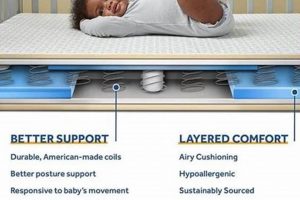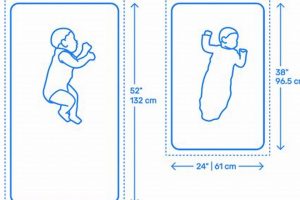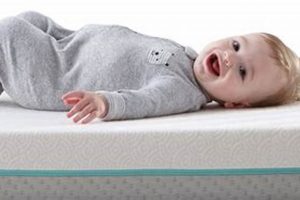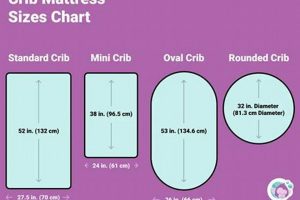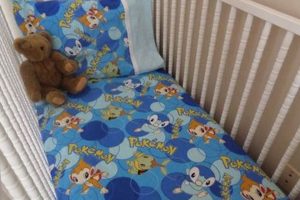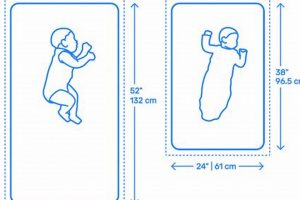A smaller sleeping surface designed for infants and toddlers is an essential component of a compact crib. This specialized mattress provides a firm, supportive area suitable for a developing musculoskeletal system, often measuring smaller than standard crib mattresses. It’s a practical solution when space is limited or when a smaller sleeping environment is preferred.
The significance of a proper sleep surface for young children cannot be overstated. It contributes to healthy spinal alignment and reduces the risk of suffocation and Sudden Infant Death Syndrome (SIDS). Historically, various materials have been employed, evolving from simple straw-filled sacks to advanced foam and coil systems engineered for optimal support and safety.
Evaluating suitable sleep surfaces involves careful consideration of factors such as material composition, firmness, size conformity with mini crib dimensions, safety certifications, and overall construction. These elements are crucial in ensuring a secure and comfortable resting environment for infants and toddlers.
Tips for Selecting a Suitable Infant Sleep Surface
Choosing the appropriate sleep surface for an infant requires careful consideration. Prioritizing safety, support, and durability is paramount. The following guidelines offer direction in this crucial decision-making process.
Tip 1: Confirm Size Compatibility: Verify that the mattress dimensions precisely match the internal measurements of the mini crib. Gaps between the mattress edge and crib frame can present entrapment hazards.
Tip 2: Evaluate Firmness: The surface should be firm to the touch. A firm surface reduces the risk of suffocation and supports healthy infant development.
Tip 3: Investigate Material Composition: Opt for hypoallergenic and non-toxic materials. Certifications like GREENGUARD Gold indicate reduced chemical emissions, promoting a healthier sleep environment.
Tip 4: Assess Cover Fabric: Select a cover that is water-resistant and easy to clean. This aids in maintaining hygiene and prolonging the mattress lifespan.
Tip 5: Review Safety Standards: Ensure the product meets or exceeds current safety standards established by organizations such as the Consumer Product Safety Commission (CPSC).
Tip 6: Examine Construction Quality: Thoroughly inspect the stitching and overall construction. Durable construction contributes to longevity and safety.
Tip 7: Consider Weight: A lighter mattress simplifies sheet changes and crib maintenance, but ensure that the weight does not compromise structural integrity.
By adhering to these guidelines, caregivers can make informed choices regarding an infant’s sleeping environment, fostering safety and promoting restful sleep.
These crucial safety and selection tips serve as a foundation for a more detailed discussion regarding specific brands and models.
1. Firmness
Firmness is a critical attribute that defines a safe and supportive sleep surface for infants. Within the context of a suitable sleeping surface for compact cribs, appropriate firmness directly mitigates the risk of infant suffocation and contributes to healthy musculoskeletal development.
- Reduced Suffocation Risk
An overly soft sleep surface increases the potential for an infant to sink into the material, obstructing airways. A firmer mattress provides resistance, minimizing this risk. Products considered the sleep surface for compact cribs must adhere to firmness standards established by safety organizations to ensure compliance.
- Spinal Support and Development
Infant spinal development necessitates adequate support. A too-soft mattress can lead to improper spinal alignment and potential long-term musculoskeletal issues. Mattresses designed for infants must offer a level of resistance that supports the natural curvature of the spine.
- Regulatory Standards and Testing
Regulatory bodies establish guidelines for firmness to ensure consumer safety. Mattresses undergo rigorous testing to evaluate their firmness level and confirm compliance with safety regulations. Failure to meet these standards can result in product recalls and potential legal repercussions.
- Material Composition and Firmness
The firmness of a mattress is intrinsically linked to the materials used in its construction. High-density foam, for instance, provides a firmer surface compared to low-density alternatives. Therefore, material selection is a critical factor in determining the overall firmness and suitability of a infant mattress.
These interconnected facets highlight the paramount importance of firmness in a mattress for compact cribs. Prioritizing a firm, supportive surface is essential for promoting infant safety and fostering healthy development. Considering these aspects ensures an informed purchase decision, minimizing potential risks associated with improper firmness levels.
2. Size Compatibility
Size compatibility is a non-negotiable aspect of selecting a suitable sleep surface for smaller cribs. Discrepancies between mattress dimensions and the interior crib frame create hazardous gaps. These gaps can lead to infant entrapment, posing a significant safety risk. A correctly sized mattress fits snugly within the crib, eliminating potential pinch points and ensuring a secure sleep environment. Therefore, achieving dimensional conformity is not merely a preference but a critical safety imperative.
The selection process involves meticulous measurement. The interior dimensions of the compact crib must be precisely determined and compared against the stated dimensions of the potential mattress. A discrepancy of even a few centimeters can negate the safety benefits and introduce potential risks. A common scenario illustrates this point: a mattress marketed as fitting all smaller cribs is purchased without verifying the actual measurements. The resulting gaps necessitate the immediate return of the mattress and a renewed search for a correctly sized alternative. Some mattress manufacturers provide detailed sizing charts to assist consumers in making informed decisions.
In summary, size compatibility functions as a foundational safety element in the purchase of a sleep surface for smaller cribs. Ensuring a precise fit eliminates the risk of entrapment and fosters a secure sleep environment. Challenges arise when relying solely on generalized marketing claims, emphasizing the importance of independent verification of dimensions. Prioritizing this aspect contributes directly to infant safety and overall peace of mind for caregivers.
3. Material Safety
Material safety is paramount when evaluating sleep surfaces for compact cribs. An infant’s prolonged exposure to potentially harmful chemicals within mattress materials can result in adverse health effects. Therefore, the selection process must prioritize mattresses constructed from non-toxic, hypoallergenic materials. The presence of volatile organic compounds (VOCs), flame retardants, and phthalates in conventional mattresses presents a tangible risk. These substances can off-gas, leading to respiratory irritation, allergic reactions, and potential long-term health consequences. For instance, mattresses lacking proper certification may contain formaldehyde, a known carcinogen. The practical significance of this understanding lies in its direct impact on safeguarding infant well-being.
Certification programs, such as GREENGUARD Gold and CertiPUR-US, provide independent verification of low chemical emissions and material composition. These certifications offer a level of assurance that the sleep surface meets stringent safety standards. A mattress bearing the GREENGUARD Gold label, for example, has undergone rigorous testing to ensure minimal VOC emissions, contributing to a healthier indoor air quality. Furthermore, organic cotton and wool offer natural alternatives to synthetic materials, reducing the potential for chemical exposure. The selection of such materials demonstrates a proactive approach to minimizing potential health risks associated with conventional mattress components.
In conclusion, material safety forms a cornerstone in the assessment of suitable sleep surfaces for compact cribs. The detrimental effects of chemical exposure necessitate a vigilant approach, prioritizing non-toxic and certified materials. Independent verification through certification programs provides valuable guidance, enabling informed purchasing decisions. The ultimate goal remains the creation of a safe and healthy sleep environment, mitigating potential risks and fostering optimal infant development.
4. Cleanability
Maintaining a hygienic sleep environment is paramount for infant health. Within the context of sleep surfaces for compact cribs, cleanability directly affects the reduction of allergens, bacteria, and potential irritants. The ease with which a sleep surface can be cleaned and sanitized is a significant factor in determining its suitability for infant use.
- Water Resistance and Stain Protection
A water-resistant or waterproof cover is essential. Infant mattresses are frequently exposed to spills, drool, and diaper leaks. A surface that resists liquid penetration prevents the absorption of moisture and the subsequent growth of mold and bacteria within the mattress core. Wipeable surfaces simplify routine cleaning and minimize the potential for staining. For example, a polyurethane-coated surface offers superior protection compared to untreated fabric.
- Removable and Washable Covers
A removable cover allows for more thorough cleaning. Machine-washable covers provide the convenience of sanitizing the surface in a standard washing machine. This feature is particularly beneficial for addressing persistent stains or odors. Covers should be easy to remove and replace without compromising the mattress’s structural integrity or fit within the crib.
- Material Composition and Cleaning Agents
The material composition of the mattress and cover influences the choice of cleaning agents. Harsh chemicals may damage certain materials or leave behind harmful residues. Mild, non-toxic cleaning solutions are preferable. Surfaces should be compatible with common cleaning agents used in infant care, such as diluted bleach solutions or enzymatic cleaners, while still maintaining their integrity and safety.
- Seam Construction and Design
The design and construction of seams can impact cleanability. Intricate or deeply recessed seams can trap dirt and moisture, making thorough cleaning difficult. Smooth, sealed seams are easier to wipe down and sanitize. Mattress designs that minimize crevices and potential collection points promote a more hygienic sleep environment.
In conclusion, cleanability is an indispensable attribute of a suitable mattress for compact cribs. Water resistance, removable covers, material compatibility, and seam design all contribute to the ease and effectiveness of maintaining a hygienic sleep surface. These factors directly impact infant health and well-being, underscoring the importance of prioritizing cleanability in the mattress selection process.
5. Support
Within the domain of infant sleep solutions, the term “support” denotes the capacity of a sleep surface to provide appropriate spinal alignment and weight distribution. The significance of this attribute is amplified when considering smaller crib mattresses, as dimensional constraints necessitate careful engineering to achieve optimal support. Proper support contributes directly to infant comfort and musculoskeletal development.
- Core Construction and Density
The core material and its density are fundamental determinants of support. High-density foam or innerspring systems provide a firmer, more supportive surface than low-density alternatives. For example, a high-density foam core distributes weight evenly, minimizing pressure points and maintaining spinal alignment. Conversely, a low-density core may compress excessively, leading to postural imbalances and discomfort.
- Edge Support and Stability
Edge support is crucial for preventing sagging and ensuring a consistent sleep surface across the entire mattress. Reinforced edges enhance stability, particularly as infants begin to move and explore their sleep environment. Without adequate edge support, the perimeter of the mattress may deform, creating an uneven surface and potentially increasing the risk of entrapment.
- Weight Distribution and Pressure Relief
Effective support facilitates even weight distribution, minimizing pressure points that can disrupt sleep and cause discomfort. Pressure relief is particularly important for infants, whose skin is more delicate and susceptible to pressure-related irritation. A mattress with adequate support contours to the infant’s body, distributing weight across a wider area and reducing localized pressure.
- Long-Term Durability and Support Retention
The ability of a mattress to maintain its support characteristics over time is a key indicator of its quality and suitability. A mattress that initially provides adequate support may degrade rapidly with use, losing its firmness and compromising its ability to properly support the infant. Durable materials and robust construction contribute to long-term support retention, ensuring consistent comfort and safety throughout the mattress’s lifespan.
The aforementioned facets collectively underscore the critical role of support in the context of smaller crib mattresses. A well-supported sleep surface promotes healthy spinal alignment, minimizes pressure points, and ensures a stable sleep environment. Prioritizing these elements contributes directly to infant comfort, safety, and optimal musculoskeletal development. Compromises in support can have tangible and detrimental consequences for the infant’s well-being.
Frequently Asked Questions About Smaller Crib Mattresses
The following questions address common concerns and misconceptions regarding smaller crib mattresses, offering clarity for informed decision-making.
Question 1: What are the standard dimensions of a sleeping surface designed for smaller cribs?
While variations exist, a typical mattress for compact cribs measures approximately 24 inches wide and 38 inches long. However, precise measurements may differ, necessitating verification with the specific crib manufacturer’s guidelines. Failure to confirm compatibility can result in hazardous gaps between the mattress and crib frame.
Question 2: How does the firmness of a smaller crib mattress impact infant safety?
Firmness is a critical safety factor. An overly soft mattress poses a suffocation risk. Regulatory standards mandate a firm sleep surface for infants to mitigate this hazard. The mattress should resist indentation and provide adequate support for healthy spinal development.
Question 3: What materials are considered safest for constructing sleeping surfaces designed for smaller cribs?
Non-toxic and hypoallergenic materials are paramount. Look for certifications such as GREENGUARD Gold, indicating low chemical emissions. Organic cotton, natural latex, and high-density foam are often preferred due to their reduced risk of allergic reactions and off-gassing.
Question 4: How often should a mattress for smaller cribs be cleaned?
Regular cleaning is essential. Spills and accidents should be addressed immediately. The mattress cover should be wiped down weekly with a mild detergent. If the cover is removable and machine-washable, it should be laundered monthly or as needed. Maintaining a hygienic surface reduces the risk of bacterial growth and allergen accumulation.
Question 5: What are the key indicators that a sleeping surface designed for a smaller crib needs replacement?
Visible signs of wear and tear, such as sagging, indentations, or tears, indicate the need for replacement. A decrease in firmness or compromised structural integrity also warrants immediate attention. It is generally recommended to replace a mattress after two to three years of use, even if no obvious damage is present.
Question 6: Are there specific regulatory standards governing the safety of smaller crib mattresses?
Yes. Consumer Product Safety Commission (CPSC) standards apply to all crib mattresses, including those designed for smaller cribs. These standards address issues such as firmness, flammability, and chemical emissions. Compliance with CPSC regulations is essential for ensuring infant safety.
The information presented provides a foundation for understanding the critical factors involved in selecting and maintaining smaller crib mattresses. Prioritizing safety, material composition, and compliance with regulatory standards is essential for safeguarding infant well-being.
The following section delves into specific mattress brands and models, offering a comparative analysis based on the criteria discussed.
Conclusion
The preceding analysis has underscored the multifaceted considerations essential for selecting a suitable sleeping surface for compact cribs. Firmness, size compatibility, material safety, cleanability, and support are all indispensable attributes that collectively contribute to infant well-being. The pursuit of the ideal infant sleep surface necessitates a comprehensive evaluation of these factors, with a primary emphasis on safety and adherence to regulatory standards. The “best mini crib mattress” is therefore not a singular product, but rather one that appropriately balances these critical elements in accordance with individual needs and circumstances.
Ultimately, the decision regarding an infant’s sleep environment carries significant weight. Ongoing research and technological advancements will likely yield further refinements in mattress design and safety features. Diligence in seeking out certified products and maintaining a proactive awareness of evolving safety guidelines will remain paramount. The future of infant sleep safety depends on informed consumer choices and continued innovation in mattress technology.


